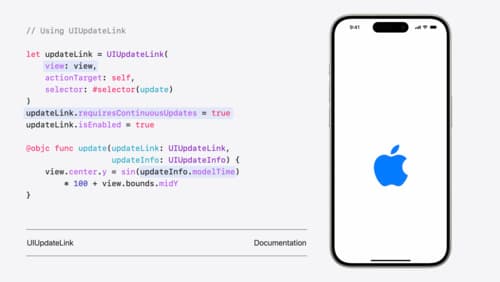How has SwiftUI changed from last year's WWDC?
Asked on 2024-08-04
1 search
SwiftUI has seen several significant changes and improvements from last year's WWDC. Here are some of the key updates:
-
Previews and Customizations:
- Xcode Previews: A new dynamic linking architecture uses the same build artifacts for previews and when you build and run, avoiding the need to rebuild your project when switching between the two. This results in a smoother and more productive workflow. Additionally, a new previewable macro allows the use of dynamic properties like state directly in an Xcode preview, reducing the amount of code needed (Platforms State of the Union).
- Customizations: New options to customize window behavior and styling in macOS, including control over the Windows toolbar and background. A new text renderer API enables advanced visual effects and animations (Platforms State of the Union).
-
Interoperability:
- UIKit and AppKit Integration: Gesture recognition has been factored out of UIKit, allowing any built-in or custom UI gesture recognizer to be used in SwiftUI view hierarchies. Animations have also been factored out, enabling animations on UIKit or AppKit views to be driven by SwiftUI, including fully custom animations (Platforms State of the Union).
- SwiftUI Animations in UIKit: You can now use SwiftUI animation types to animate UIKit views, making it easier to build fluid gesture-driven animations (What’s new in UIKit).
-
New Features and Enhancements:
- Graphics Capabilities: A new mix modifier on color allows blending colors by a given amount. The custom shader feature now supports precompiling shaders to avoid frame drops caused by lazy shader compilation (What’s new in SwiftUI).
- Scrolling Enhancements: New APIs provide fine-grained control over scroll views, including reacting to changes in content offsets and sizes, detecting view visibility changes due to scrolling, and more programmatic control over scroll positions (What’s new in SwiftUI).
- Swift 6 Language Mode: The new Swift 6 language mode enables compile-time data race safety, and SwiftUI has improved its APIs to make it easier to adopt this new mode (What’s new in SwiftUI).
-
Adoption and Use Cases:
- SwiftUI is being used extensively across Apple's own apps and system experiences, such as the new Image Playground app, the redesigned Photos app, and the Music app, which now uses SwiftUI across multiple platforms (Platforms State of the Union).
These updates reflect a continued investment in making SwiftUI a powerful and flexible tool for building user interfaces across all Apple platforms.

Platforms State of the Union
Discover the newest advancements on Apple platforms.

What’s new in SwiftUI
Learn how you can use SwiftUI to build great apps for any Apple platform. Explore a fresh new look and feel for tabs and documents on iPadOS. Improve your window management with new windowing APIs, and gain more control over immersive spaces and volumes in your visionOS apps. We’ll also take you through other exciting refinements that help you make expressive charts, customize and layout text, and so much more.

What’s new in UIKit
Explore everything new in UIKit, including tab and document launch experiences, transitions, and text and input changes. We’ll also discuss better-than-ever interoperability between UIKit and SwiftUI animations and gestures, as well as general improvements throughout UIKit.
